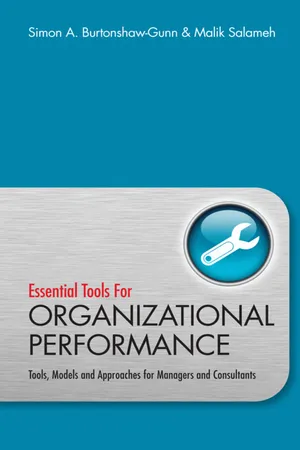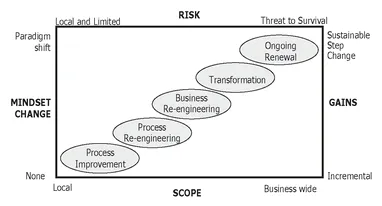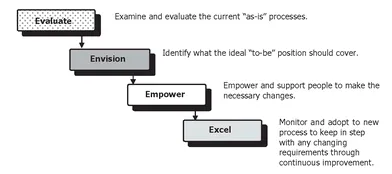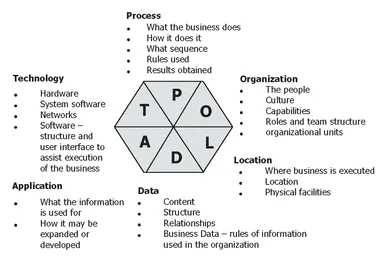![]()
CHAPTER 1
PROCESS IMPROVEMENT
DEVELOPMENTS IN PROCESS MANAGEMENT
Businesses, whether commercial or not-for-profit organizations, inevitably have a wish to remain in operation; to have sustainable and repeatable business; and to satisfy stakeholders, customers and employees. For many, this brings a need to examine their operations in order to improve and advance such objectives. While organization change is covered in detail in Chapter 2 and the people aspects of performance management and organizational development in Chapter 3, a deliberate starting point for such change may be the examination of current practices and processes. Against this backdrop, process improvement can be regarded as being a systematic effort to provide an understanding of every aspect of a company’s processes in order to reduce rework, variation and needless complexity in order to contribute to its performance through effectiveness and efficiency. It should be noted that process identification and redesign only provides a benefit when it is actually implemented and hence this also suggests a natural link to a change management programme.
Completion of a process improvement examination exercise is often seen to be a traditional springboard for much larger business improvements, which may in turn incrementally develop into a large-scale change management programme and planned organizational development. Indeed, what may begin as a simple local business improvement may grow into other initiatives aimed at delivering more substantial change and hence increased business-wide implications. The evolution through a range of such business programmes is shown in Figure 1.1.
Figure 1.1 The re-engineering spectrum.
(From Business Process Re-engineering: Myth and Reality. Professor Colin Coulson-Thomas, 1996, reproduced with permission of Kogan Page.)
With every organizational change there comes a risk which usually manifests itself through deterioration in business performance; however, a performance management system with associated key performance indicators can be used to help management teams predict and mitigate such an impact. This suggests that process improvement may be made in conjunction with the introduction of a change management programme which may be instigated to realign the culture and business targets. Nevertheless, it should be stressed that the ubiquity of change management initiatives within both public and private sector organizations can quite often leave stakeholders at all levels with “change fatigue”, particularly where the vision, mission and principal objectives become diluted and performance reporting data confused. This said, for any performance-based management system to really add value to the organization it will need to encourage a no-blame culture where it will be safe for individuals to highlight sources of poor performance variance and actually regard these as proactive opportunities for improvement through a step change in their process redesign activities prior to implementation. Common across the re-engineering spectrum of Figure 1.1 is the requirement to understand fully the current processes together with a desire to improve them.
Figure 1.2 Two extremes of undertaking process improvement. (From The Essential Management Toolbox: Tools, Models and Notes for Managers and Consultants. S.A. Burtonshaw-Gunn, 2008, reproducedwith permission.)
Consequently, it is essential that organizations establish a level of openness and engagement throughout the process improvement and change management lifecycle, which transcends policies, procedures and statutory obligations, and carefully consider how critical the involvement of all employees will be in helping deliver process change. While there are a number of approaches to change, there are two extremes of major step change - one being revolution and the other a more gentle, incremental change of evolution with the features of both shown in Figure 1.2. However, this is not to suggest that one of these types is good and the other poor as this choice depends on a range of circumstances and the host organization’s drivers for change. It should also be noted that a combination of these approaches is also possible although the majority of process improvements are aimed at achieving significant operational and financial improvement; as such, the revolution elements of a business process re-engineering approach such as process mapping are commonly adopted.
In considering the other extreme category of process improvement, the term evolution is aptly used as this supports a continual activity. Without such commitment, it is likely that the company’s performance will fail to keep pace with its competitors and larger change will more likely then be required. This failure is commonly referred to as “strategic drift” and is also shown in the model of Figure 2.2 in Chapter 2.
INVESTIGATING BUSINESS PROCESSES
While the obvious starting point is to gain an understanding and evaluation of an organization’s current processes in order to identify where waste and/or rework occurs, it is also possible to take a more “visionary” approach and look to producing new processes without the constraints or inhibitions imposed by an organization’s current operations and capability. This Envision stage exists in the standard business process re-engineering (BPR) methodology and requires an identification of any gaps to be undertaken and quantified in order to identify the level of transition to made to the “to-be” processes of the organization compared with those of the organization’s current “as-is” position. A widely employed approach to BPR is shown in
Figure 1.3. As mentioned above, the starting point on the model may be either at the Evaluate or Envision stage, although both stages will need to be ultimately addressed.
Figure 1.3 Business improvement process.
(From The Essential Management Toolbox: Tools, Models and Notes for Managers and Consultants. S.A. Burtonshaw-Gunn, 2008, reproduced with permission.)
One of the well-known and commonly used models in Europe is the EFQM Business Excellence model (covered as Figure 3.2 in Chapter 3), which itself has similarities to the American “Malcolm Baldrige National Quality Award”, both of which prompt organizations to look at their processes and in particular question how they are developed, used, reviewed and updated. At a higher level the Business Excellence model also promotes the use of “best practice” benchmarking with other companies and places great emphasis on performance measurement over time allowing trend analysis to be undertaken. This performance measurement can be from qualitative data from customer or employee feedback, or from quantitative data such as financial reports, defect rates, etc. and used to examine the alignment relationship of the company processes to its business and customer requirements.
Since the mid 1950s, process examination has been part of the topic of “work study”, itself a forerunner to industrial engineering and more latterly management systems. As part of the earlier industrial tools, work study was a systematic approach of a staged methodology to select, record, examine, develop, install and maintain processes with the objective of reducing waste and hence increasing industrial output and performance.
One of the models that can be used to compare and contrast similar processes in an organization, especially if these are undertaken at different locations, is the POLDAT approach first used by the American Computer Services Corporation, and shown as
Figure 1.4. This is used to record:
• the processes undertaken;
• the organizational setting;
• the location of where the processes are undertaken;
• the data that are managed;
• the application of the data; and finally
• the technology used in undertaking the task.
In addition to this internal comparison is the growing use of “benchmarking” where comparison is made with similar industries and companies to mutually seek improvement in process operations and share examples of considered good practice.
Figure 1.4 POLDAT methodology.
(From The Essential Management Toolbox: Tools, Models and Notes for Managers and Consultants. S.A. Burtonshaw-Gunn, 2008, reproduced with permission.)
The use of the POLDAT model provides a systematic approach to selecting and recording performance whether at the company, department or activity level and lends itself to being a basis of comparison with the same activities undertaken in different locations. Such a comparison prompts questions around the model components such as details of the process; the organization’s resources in terms of roles, responsibilities and numbers; and the use, level and extent of technology involved in undertaking each activity, etc. in order to perform the same work output. Where process improvement is sought across a wide geographical area, companies can often address process improvement through the establishment of virtual teams and external consultant input, or at the other extreme have their own full-time staff charged with undertaking process improvement activity across an organization. The later is more commonly used in the larger international organizations where the internal cost of establishing and operating such a team is more easily absorbed by the business. For some companies process improvement may also arise from other business activities such as problem solving.
One of the most used tools in this area is process mapping which encourages detailed investigation and analysis of how the company discharges its work. Process maps are usually presented in the form of a flow diagram and often have their own drawing convention. While flow charts may be drawn in a common IT program such as Microsoft Powerpoint or Excel, there are a number of process-mapping software programs such as Visio, FlowCharter Plus and Process Expert Professional, the latter being favoured by some UK police forces, for example. When considering the process language there are a number of mapping conventions such as British Standards, ASME Standard for Process Charts, etc. In widespread use is the internationally recognized Unified Modelling Language. However, the choice of these is of little consequence as it is the task of process mapping itself that provides an understanding of the current processes that can later be developed into new processes aimed at providing real performance benefits. If the process cannot be drawn using these mapping symbols then it is suggested that the process itself is not sufficiently understood. In view of the timing - or, perhaps more accurately, the order - of such an investigation the starting points of Evaluate or Envision shown in the business improvement process in Figure 1.3 again suggest either of these two stages provides an appropriate starting point providing that this is supported by the organization and those requesting an analysis of the organization’s processes and performance.
Process improvement can also draw heavily on benchmarking an organization’s processes with those of other businesses, although in practice finding “best practice” examples is not always easy, and often some examples are difficult to transfer between companies due to cultural or other operational differences. This is not to suggest that benchmarking is of no value, but that the elements of best practice championed by one organization may not always be applicable to others. It should also be noted that closer collaborative working (see Chapter 5) can also provide useful insights into process performance improvements where instead of whole process transfers, smaller “nuggets” of best practice may be identified which can be incorporated into providing increased organizational performance. The following six-ste...





